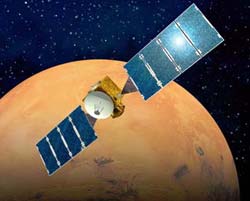Going to Mars for Christmas

Mars Express is the first flexible mission in the revised ESA long-term scientific programme which was launched towards Mars in June 2003 with a Soyuz/Fregat launcher. <br>Credits: ESA-D. Ducros
Europe’s mission to the Red Planet, Mars Express, is on schedule to arrive at the planet on Christmas Day, 2003.
The lander, Beagle 2, is due to descend through the Martian atmosphere and touch down also on 25 December.
Mars Express is now within 20 million kilometres of the Red Planet and the next mission milestone comes on 19 December, when Mars Express will release Beagle 2. The orbiter spacecraft will send Beagle 2 spinning towards the planet on a precise trajectory.
Into orbit
Beagle has no propulsion system of its own, so it relies on correct aiming by the orbiter to find its way to the planned landing site, a flat basin in the low northern latitudes of Mars.
ESA engineers will then fire the orbiter’s main engine in the early hours of 25 December to put Mars Express into orbit around Mars (called Mars Orbit Insertion, or MOI).
Landing
When Beagle 2 begins its descent, it will be slowed by friction with the Martian atmosphere. Nearer to the surface, parachutes will deploy and large gas-filled bags will inflate to cushion the final touchdown. Beagle 2 should bounce to a halt on Martian soil early on Christmas morning.
The first day on Mars is important for the lander because it has only a few hours to collect enough sunlight with its solar panels to recharge its battery.
Waiting for signal
We then have to wait for the radio ’life’ signal from Beagle 2, relayed through the US Mars Odyssey spacecraft, to see if the probe has survived the landing. This could take hours or even days.
If nothing is received on Christmas morning, the UK Jodrell Bank Telescope will search for the faint radio signal from Beagle 2 in the evening. The Mars Express orbiter can also search for the lander but, because of its orbit, it will not be in place to do this until early January.
If all goes well, Mars Express and Beagle 2 will then begin their main mission – trying to answer the questions of whether there has been water, and possibly life, on Mars.
Media Contact
More Information:
http://www.esa.int/export/SPECIALS/Mars_Express/SEMT92XLDMD_0.htmlAll latest news from the category: Physics and Astronomy
This area deals with the fundamental laws and building blocks of nature and how they interact, the properties and the behavior of matter, and research into space and time and their structures.
innovations-report provides in-depth reports and articles on subjects such as astrophysics, laser technologies, nuclear, quantum, particle and solid-state physics, nanotechnologies, planetary research and findings (Mars, Venus) and developments related to the Hubble Telescope.
Newest articles

“Nanostitches” enable lighter and tougher composite materials
In research that may lead to next-generation airplanes and spacecraft, MIT engineers used carbon nanotubes to prevent cracking in multilayered composites. To save on fuel and reduce aircraft emissions, engineers…

Trash to treasure
Researchers turn metal waste into catalyst for hydrogen. Scientists have found a way to transform metal waste into a highly efficient catalyst to make hydrogen from water, a discovery that…

Real-time detection of infectious disease viruses
… by searching for molecular fingerprinting. A research team consisting of Professor Kyoung-Duck Park and Taeyoung Moon and Huitae Joo, PhD candidates, from the Department of Physics at Pohang University…





















